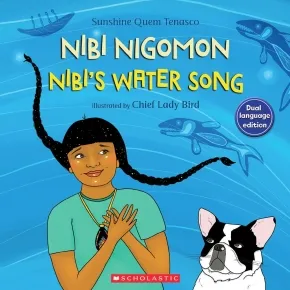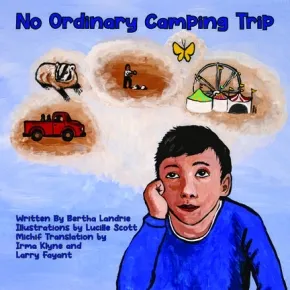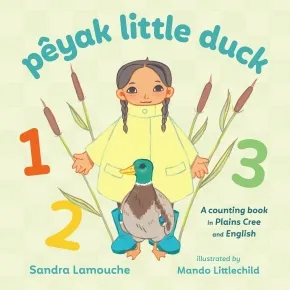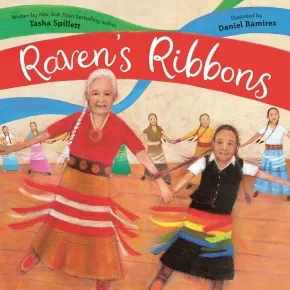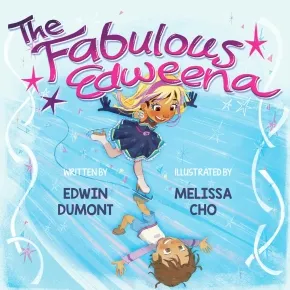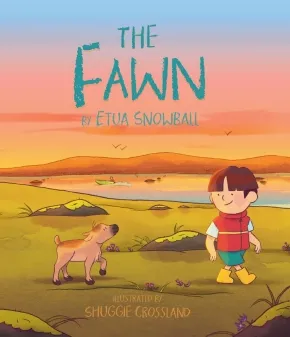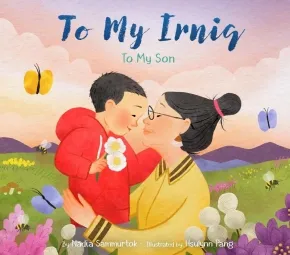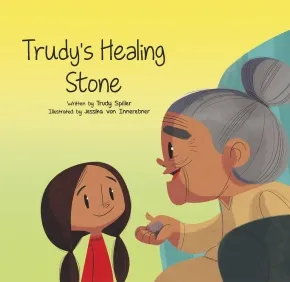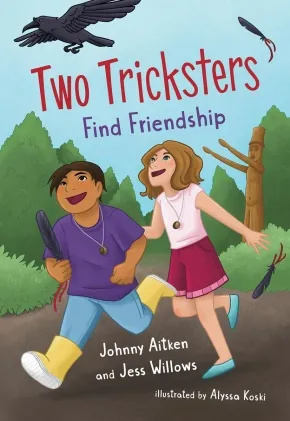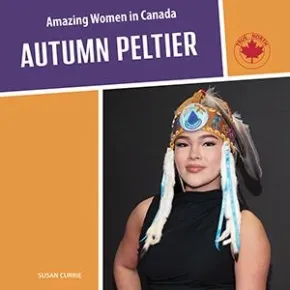
Canadian Indigenous Resource Lists
16
-
30
of
473 Results;
Sort By
Go To
of 32
My Visit to Kimmirut
$16.95
Artists:
Format:
Paperback
Text Content Territories:
Indigenous Canadian; Inuit;
Grade Levels: Preschool; Kindergarten;
ISBN / Barcode: 9781774508060
Synopsis:
Synopsis:
What will Monica see and learn when she visits a new community?
Monica is visiting her aunt Peesee in Kimmirut, Nunavut. There are many wonderful things to see and do there. Monica is excited to explore and learn about her aunt's community. Join Monica and Peesee as they go clam digging, visit waterfalls, and see the tallest trees on Baffin Island in this bilingual picture book!
Reviews
"In the story, Monica shares about visiting her aunt in Kimmirut. At the beginning of the story, she explains that the village was renamed with its traditional name (Kimmirut) from its settler name (Lake Harbour). Different cultural elements are explored: resources, arts, food, activities, and land features. As well, there is an exploration of the seasons through images, contrasting the end of summer and winter. Teachers can point out to the students that with the exception of two pages, there are no trees on the landscape. This would be a good introduction to biomes and an inquiry into the arctic tundra. While the book is written for younger students, older students could benefit from the story and extend their learning by engaging in an inquiry project about the traditional Inuktitut names that are increasingly used in Nunavut in an effort to decolonize place names. For instance, Baffin Island’s traditional Inuktitut name is Qikiqtaaluk." - Alethea S., Indigenous Books for Schools
Educator & Series Information
Recommended for ages 3 to 5.
Dual-language: English and Inuktitut
This book is part of the Community Connections series.
This title is included in the Indigenous Books for Schools database from the Association of Book Publishers of BC, recommended for K-5 English Language Arts and Social Studies.
Additional Information
23 pages | 8.00" x 9.00" | Paperback
Nibi nigomon/Nibi's Water Song
$8.99
Format:
Paperback
Text Content Territories:
Indigenous Canadian; First Nations; Anishinaabeg;
ISBN / Barcode: 9781039700673
Synopsis:
Synopsis:
Nibi is determined to bring clean water to her community.
Nibi is the Anishinabemowin word for water. In Nibi’s Water Song, Nibi is an Indigenous girl on the search for clean water to drink. Though she is faced with repeated obstacles, Nibi’s joyful and determined energy becomes a catalyst for change and action as her community rallies around her to make clean drinking water available for all.
First published in 2020, Nibi’s Water Song was shortlisted for both the IODE Jean Throop Award and longlisted for the First Nations Communities READ Award. This dual-language edition presents the text in both English and Anishinabemowin.
Educator Information
Recommended for ages 4-8.
Dual-language: English and Anishinabemowin
Translated by Tina Nottaway. Tina is an Algonquin Anicinabe Ikwe artist and translator from Rapid Lake, Quebec. She is fluent in her language, Anicinabemowin. Tina is also a crafter and facilitates workshops on moccasin making, birchbark basket making and other cultural activities.
This resource is available in English: Nibi's Water Song
This resource is also available in French: Nibi a soif, très soif
Additional Information
32 pages | 9.51" x 9.51" | Paperback
No Ordinary Camping Trip
$17.50
Artists:
Format:
Paperback
Text Content Territories:
Indigenous Canadian; Métis;
ISBN / Barcode: 9781988011363
Synopsis:
Synopsis:
In No Ordinary Camping Trip, Bertha Landrie recounts a tale from her husband, Joe’s, childhood. Many Métis families relied on seasonal employment, working for farmers, clearing fields, picking Seneca root, and other labour jobs to support themselves. In this coming-of-age story, a young Joe works hard picking rocks in order to make money to go to the North Battleford Fair. Will they be able to finish the job in time? Lucille Scott’s evocative illustrations take us back in time while capturing the story’s essence. Michif Old Ones, Irma Klyne and Larry Fayant provide a Southern Michif translation—the language of the Landrie family.
Reviews
"Rich in cultural detail, the story introduces young readers to aspects of Métis culture and values. The book celebrates themes of family, resilience, and identity. Suitable for grades three to five Social Studies and Language Arts, it supports curricular goals related to Indigenous perspectives, cultural diversity, and belonging, while promoting early bilingual literacy through its inclusion of Michif. Narrations in English and Michif are available through a link provided by the publisher, and supplementary information about the Road Allowance period in Métis history is also provided." - Bonny-Lynn D., Elementary School Teacher, Indigenous Books for Schools
Educator Information
Recommended for Grades 3 to 5.
Dual-language format: Michif and English.
Themes: Childhood; Coming of Age; Family; Intergenerational Roles
This title is included in the Indigenous Books for Schools database from the Association of Book Publishers of BC. It's recommended for Grades 3 to 5 for English Language Arts and Social Studies.
Additional Information
37 Pages | 9" x 9" | Paperback
Omaamakaadendaagozi Edwiina / The Fabulous Edweena
$21.95
Artists:
Format:
Hardcover
Text Content Territories:
Indigenous Canadian; First Nations; Anishinaabeg; Ojibway;
ISBN / Barcode: 9781772604078
Synopsis:
Synopsis:
Edwin loves his sister Patsy's closet. He adores dresses and earrings and boots with high heels. And when he's finished getting dressed, Edwin is transformed...into the fabulous Edweena!
Today is the figure skating competition at school and Edwin has decided to compete as Edweena. What will people say when they meet her for the first time? Can a boy in drag win the competition? Edweena will have to give her best performance ever to find out!
Reviews
"Edwin Dumont’s The Fabulous Edweena is written in English and celebrates the Anishinaabemowin (Ojibwe) language through translations by Angela Mesic and Margaret Noodin. Inspired by Dumont’s own childhood experiences—including dressing up in his sisters’ clothes—the story follows Edweena as she prepares for a local figure skating competition. Though nervous about how others might react, Edweena sees the event as a chance to express herself through drag. Cautiously, she takes to the ice in her sisters’ clothes—and is met with unexpected support and encouragement. This heartwarming story highlights the courage it takes to be true to yourself and reminds readers that authenticity, even when scary, can lead to acceptance and joy." - Debra H., Elementary School Teacher, Indigenous Books for Schools
Educator Information
Recommended for ages 6 to 8.
Dual-language: Anishinaabemowin (Ojibwe) and English.
This book is available in English: The Fabulous Edweena
This title is included in the Indigenous Books for Schools database from the Association of Book Publishers of BC. It is recommended for Grades 1 to 3 for English Language Arts and Physical and Health Education.
Additional Information
24 pages | 8.50" x 8.50" | Hardcover
pêyak little duck
$21.95
Artists:
Format:
Hardcover
Text Content Territories:
Indigenous Canadian; First Nations; Cree (Nehiyawak); Plains Cree;
ISBN / Barcode: 9781459837171
Synopsis:
Synopsis:
Let's go on a walk and practice our language!
What birds will we see? I see one sîsîp / pêyak little duck!
In a celebration of the connection between language learning and the land, a young child enjoys a walk in nature and spots different birds while practicing counting from one to ten in Plains Cree. With bright illustrations, rhyming clues in English and pronunciation guides on every page, pêyak little duck is a friendly introduction to Plains Cree and a celebration of the beauty of springtime in the Prairies and the Plains.
Reviews
"Ideal for families, educators, and those beginning their exploration of Indigenous languages, peyâk little duck is a wonderful contribution to language preservation and a celebration of identity through storytelling." - Anika L., Middle School Teacher, Indigenous Books for Schools
Educator Information
Recommended for ages 3 to 5.
Learn to count from one to ten in Plains Cree. Simple rhyming English text complements Plains Cree vocabulary to help readers learn and practice the numbers one through ten. Illustration labels for birds and other natural objects are an opportunity for additional language learning.
Pronunciations are given beside each Cree number to support readers in their learning. The rhyme and rhythm of the English text also provides clues about how the Cree is pronounced. Additional pronunciations and information about language learning are provided in the back matter.
This title is included in the Indigenous Books for Schools database from the Association of Book Publishers of BC. It is recommended for K to 3 classrooms for English Language Arts.
Additional Information
32 pages | 9.00" x 9.00" | Hardcover
Pow-wow: Je compte en cri
$12.99
Artists:
Format:
Paperback
Text Content Territories:
Indigenous Canadian; First Nations; Cree (Nehiyawak);
Grade Levels: Preschool; Kindergarten;
ISBN / Barcode: 9781039709447
Synopsis:
Synopsis:
Apprenez à compter jusqu’à dix en cri grâce aux images et aux sons d’un pow-wow.
Ce livre de comptage unique initie les enfants aux chiffres d’un à dix en cri des plaines. À chaque page, vous découvrirez des illustrations vibrantes qui reflètent la richesse de la culture et des traditions du peuple cri. Grâce aux rimes, au rythme et aux illustrations représentatives des pow-wow, ce livre fait de l’apprentissage des langues une expérience joyeuse pour les jeunes lecteur·rices.
Educator Information
Recommended for ages 3 to 8.
Recommended for ages 3 to 8.
This book is available in English: Powwow Counting in Cree
Additional Information
24 Pages | Paperback
24 Pages | Paperback
Raven's Ribbons
$22.95
Artists:
Format:
Hardcover
Text Content Territories:
Indigenous Canadian;
ISBN / Barcode: 9781771475662
Synopsis:
Synopsis:
A joyous celebration of gender expression through an Indigenous lens, by New York Times bestselling author Tasha Spillett and Ojibwe elder Daniel Ramirez
Raven loves round dances. The drums sing to the people, and the people dance to their songs. Raven especially loves dancing with his grandma, sidestepping to the rhythm of the drums. His favourite part of all is watching the ribbon skirts swirl like rainbows.
"Nohkum, do you think a boy could wear a ribbon skirt?" Raven asks his grandmother one day. She tells him she has lived for a long time, but she has never seen it. That evening, she sews late into the night, and Raven awakes to a rainbow skirt of his own. "I've lived for a long time," his grandma says, "and I'm lucky to see beautiful things that I've never seen before." At the next dance, Raven wears the swirl of unique ribbons with pride.
With illustrations infused with joy and colour, this moving intergenerational story celebrates self-expression, honouring traditions, and finding room for reinvention.
Reviews
"Weaves Two-Spirit self-expression and collective belonging into a beautiful tribute to Indigenous heritage." — Kirkus Reviews - STARRED REVIEW
"Cree author Spillett (I Sang You Down from the Stars) captures the joy of the round dance, and a feeling of belonging and connection offered in intergenerational Indigenous community." — Publishers Weekly - STARRED REVIEW
"[A] welcome story about an Indigenous child's gender expression." — The Horn Book
"In this heartfelt story, Spillett shows that love and support matter more than tradition, gently challenging expectations while honouring culture." - Debra H., Elementary School Teacher, Indigenous Books for Schools
Educator Information
Recommended for ages 4 to 7.
This title is included in the Indigenous Books for Schools database from the Association of Book Publishers of BC. It is recommended for Grades 2 to 4 for English Language Arts, Art, Dance, Music, and Social Studies.
Additional Information
32 pages | 9.00" x 9.00" | Hardcover
The Fabulous Edweena
$21.95
Artists:
Format:
Hardcover
Text Content Territories:
Indigenous Canadian; First Nations; Anishinaabeg; Ojibway;
ISBN / Barcode: 9781772604047
Synopsis:
Synopsis:
Edwin loves his sister Patsy's closet. He adores dresses and earrings and boots with high heels. And when he's finished getting dressed, Edwin is transformed...into the fabulous Edweena!
Today is the figure skating competition at school and Edwin has decided to compete as Edweena. What will people say when they meet her for the first time? Can a boy in drag win the competition? Edweena will have to give her best performance ever to find out!
Educator Information
Recommended for ages 6 to 8.
This books available in English and Anishinaabemowin (Ojibwe): Omaamakaadendaagozi Edwiina / The Fabulous Edweena
This title is included in the Indigenous Books for Schools database from the Association of Book Publishers of BC. It is recommended for Grades 1 to 3 for English Language Arts and Physical and Health Education.
Additional Information
24 pages | 8.50" x 8.50" | Hardcover
The Fawn
$22.95
Artists:
Format:
Hardcover
Text Content Territories:
Indigenous Canadian; Inuit;
ISBN / Barcode: 9781772275223
Synopsis:
Synopsis:
In a surprising and heart-warming story, Etua Snowball shares his childhood experience of meeting and befriending a baby caribou.
After a chance encounter with a herd of caribou, a fawn follows a young boy back to his cabin. The boy and fawn spend the summer together exploring the northern landscape, picking berries, and swimming in the lake. Then one day the boy and fawn get an unexpected visitor, and the boy must learn how to say goodbye to his furry friend.
Reviews
"Through vivid storytelling and Shuggie Crossland’s expressive illustrations, The Fawn deepens cultural understanding and offers insight into Inuit ways of life and resilience. The book supports the BC curriculum by exploring how local environments shape identity and ways of living and encourages discussions on kindness, responsibility, and our relationship with nature. A glossary and pronunciation guide for Inuktitut words is included." - Shannon D., Elementary & Middle School Teacher, Indigenous Books for Schools
Educator & Series Information
Recommended for ages 6 to 8.
This book is part of the My Wild Arctic Friends series.
This book is included in the Indigenous Books for Schools database from the Association of Book Publishers of BC as a recommended resource for K to 3 for the following subjects: English Language Arts, Science, and Social Studies.
Additional Information
28 pages | 8.00" x 9.00" | Hardcover
The Game
$23.95
Artists:
Format:
Hardcover
Text Content Territories:
Indigenous Canadian; First Nations; Salish; Coast Salish; Musqueam;
ISBN / Barcode: 9781778401756
Synopsis:
Synopsis:
A beautifully illustrated reimagining of the origins of hockey from an Indigenous lens.
Killer Whale and Brown Bear are arguing: Brown Bear says he can beat Killer Whale at any challenge, yet Killer Whale disagrees. When Powerful Mena overhears their bickering, he comes up with a solution: a game on the ice, played with sticks, nets, and a star for a puck. But who will win and earn the trophy?
For kids aged 4-8, The Game features:
- An introduction to Musqueam language and culture
- Beautiful watercolor artwork from a celebrated Haida artist
- Detailed backmatter and a pronunciation guide
With poetic text by gifted Indigenous storyteller Henry Charles (Ten Bears), an elder of the Musqueam First Nation, and breathtaking illustrations by Haida artist, Shoshannah Greene, The Game offers a vibrant introduction to Musqueam language and culture and inspires readers to rediscover a sport we know and love.
Reviews
"This book is written in English with some words in hən̓q̓əmin̓əm̓. It begins with an introduction of the author, Henry Charles (Ten Bears), as the book was published posthumously. The story imagines hockey in the long ago; Mən’ə decided that a game played on ice was the only way for Killer Whale and Brown Bear to settle their dispute. Mən’ə made a trophy for the winner, but when Killer Whale wins, he declines the trophy as he is heading back to the ocean. The reward is then shared with a boy who invited others to witness the game, and he shares it with his people. Students can learn about important traditional practices (witnessing, inviting others to witness, and the use of a game to settle a dispute) through the story. Older students could use the story to learn about sportsmanship and review the characteristics of fair play." - Alethea S., Elementary School Teacher, Indigenous Books for Schools
Educator Information
Recommended for ages 4 to 8.
This title is included in the Indigenous Books for Schools database from the Association of Book Publishers of BC. It's recommended for K to 4 classrooms for English Language Arts and Physical and Health Education.
Additional Information
48 pages | 10.00" x 8.00" | Hardcover
To My Irniq: To My Son
$22.95
Artists:
Format:
Hardcover
Text Content Territories:
Indigenous Canadian; Inuit;
Grade Levels: Preschool; Kindergarten;
ISBN / Barcode: 9781772275599
Synopsis:
Synopsis:
This tenderly told follow-up to the acclaimed To My Panik: To My Daughter highlights the unique beauty of a mother-son bond. In this lovingly told book, a mother recounts for her son all the things she loves about him, connecting each attribute to an element of the Arctic landscape or Inuit traditional life. Her son is strong, like a polar bear carrying its cubs across the frozen sea. He is gentle, like a delicate blade of cottongrass. He’s as steadfast as the spark that lights the campfire, and as invigorating as a sip of icy river water. This beautiful narrative of connection and love will warm the hearts of all readers.
Reviews
"This tender story, told in a poetic question-and-response structure, celebrates the bond between a mother and child and between an Inuit family and the Arctic landscape. Ideal for shared reading in K–1 classrooms, the story invites connections to seasonal cycles while encouraging personal reflections on strength, gentleness, integrity, compassion, and humour. The illustrator’s use of soft textures and muted tones contributes to the emotional tone of the story. In English Language Arts, it supports vocabulary development and oral language comprehension. In Science, it can prompt comparisons between Arctic and British Columbian flora and fauna. In Arts Education, Pang’s use of space and perspective to express scale can be explored through watercolour or pastel art techniques." - Bonny-Lynn D., Elementary School Teacher, Indigenous Books for Schools
Educator Information
Recommended for ages 3 to 5.
This title is included in the Indigenous Books for Schools database from the Association of Book Publishers of BC as a recommended resource for kindergarten and Grade 1 for the following subjects: English Language Arts, Art, Science, and Social Studies.
Additional Information
28 pages | 9.50" x 8.50" | Hardcover
Trudy's Healing Stone (PB)
$10.95
Artists:
Format:
Paperback
Text Content Territories:
Indigenous Canadian; First Nations; Gitxsan (Gitksan);
ISBN / Barcode: 9781778540691
Synopsis:
Synopsis:
Everyone gets sad, angry, frustrated and disappointed. Difficult emotions are a natural part of life. In this book, Trudy's Healing Stone, Trudy Spiller shares a special teaching about a practice that anyone can use to help them process their feelings with the help of Mother Earth.
Educator Information
Recommended for ages 4-6
This rhyming book is an adaptation of Trudy’s Rock Story for a younger audience (ages 4-6).
A few Gitxsan words and how to say them are included at the end of the book.
This book is also available in French: Le caillou de guérison de Trudy.
Recommended in the Canadian Indigenous Books for Schools 2020/2021 resource list for Grades Pre-K to 1 for English Language Arts.
Additional Information
28 pages | 7.87" x 7.09" | Paperback
Two Tricksters Find Friendship
$8.95
Format:
Paperback
Text Content Territories:
Indigenous Canadian; First Nations; Salish; Coast Salish;
ISBN / Barcode: 9781459839281
Synopsis:
Synopsis:
Friendship can overcome any obstacle.
To Jessie and Johnny, their friendship is easy.
Jessie and Johnny have been inseparable ever since Jessie moved to the small island town during summer break. But as they begin fourth grade together, the new school year gets off to a rocky start when outside pressures and differences in their home lives threaten their friendship. Jessie lives comfortably and never worries about money while Johnny lives with his father and stepmother on the reserve outside of town. With guidance from Raven and spiritual teacher, Steven, the two friends bridge the gaps between them and learn to lean on each other through family troubles and cultural differences.
Reviews
"From the first paragraph, I was hooked. This is a beautiful story about friendship, family and community. The characters take us on adventures of discovering the connection to land, animals and history. Their friendship helps us understand how we care for each other on this journey of truth and reconciliation. My new favorite book!”— Monique Gray Smith, award-winning author of My Heart Fills With Happiness
“Set in the peace of a rural coastal community, this thoughtful and inspiring book creates space not just for playful adventure but reflection, curiosity and learning. Young Jessie and Johnny demonstrate the power of true friendship to bridge cultural difference, and their story shows us that wisdom comes from many kinds of teachers—the land, trickster Raven, Elders and, importantly, one another. Well-paced and charmingly illustrated, this book draws you into a beautiful world among trees and berry bushes, at the beach and the Bighouse, and it teaches that approaching each other with openness, support and respect allows for the discovery of many gifts.”— Amy Reiswig, reviewer, writer, editor
"This story blends Indigenous Knowledge and perspectives with themes of diversity and cultural teachings, making it a meaningful read-aloud for elementary classrooms or a thoughtful addition to a beginning reader’s library." - Debra H., Elementary School Teacher, Indigenous Books for Schools
Educator & Series Information
Recommended for ages 6 to 8.
This book is part of the Orca Echoes series.
Key features:
- Two friends face the fourth grade together while learning to overcome cultural prejudices. Reconciliation is exemplified by a friendship between a non-Indigenous child and an Indigenous child.
- The authors use fictional versions of their younger selves to reimagine what it would be like if they met as children today.
- Extended family are shown as key supporters for Johnny and Jessie, and positive relationships with a grandmother, aunties, and a cousin are depicted.
- Coast Salish culture is celebrated by author Johnny Aitken’s own experiences and teachings.
- An Indigenous character, who identifies as 2Spirit, acts as a role model and educator to the two friends.
Reading Levels:
Fountas & Pinnell Text Level Gradient: R
Lexile measure: 720L
Guided Reading Level: R
This book is available in French: Johnny et Jessie reçoivent un message de Corbeau.
This title is included in the Indigenous Books for Schools database from the Association of Book Publishers of BC. It is recommended for Grades 2 to 5 for English Language Arts, Physical and Health Education, and Social Studies.
Additional Information
96 pages | 5.25" x 7.62" | Paperback
An Anishinaabe Christmas
$24.99
Artists:
● Erin Hill (Indigenous;)
Format:
Hardcover
Text Content Territories:
Indigenous Canadian; First Nations; Anishinaabeg; Ojibway;
ISBN / Barcode: 9781774883570
Synopsis:
Synopsis:
A festive, joyful Indigenous picture book that explores both Christmas traditions and Anishinaabe culture, for fans of Santa in the City and Go Show the World.
One winter solstice, Mommy says, "Baby, we're going home to the Rez. We're going to have an Anishinaabe Christmas." But this is Baby's first Christmas away from the city, and they're worried! They have a lot of questions:
How will Santa know where to find them?
Why do we have presents on Christmas?
How come they're going home to the Rez but don't live there?
On the long trip to Mooshom's and Kookom's, Baby learns about animals being part of their family, about the North Star leading them home and even the meanings of some Anishinaabe words. Will this Anishinaabe Christmas be Baby's best yet?
Educator Information
Recommended for ages 3 to 7.
This book is available in French: Un Noël anichinabé
Additional Information
48 pages | 9.00" x 10.25" | Hardcover
Autumn Peltier
$14.95
Format:
Paperback
Text Content Territories:
Indigenous Canadian; First Nations; Anishinaabeg; Wiikwemkoong Unceded Territory;
ISBN / Barcode: 9781774566718
Synopsis:
Synopsis:
Only 19 years old, Autumn Peltier has achieved so much by advocating for her community. Discover more about her advocacy for Indigenous peoples and clean water.
Reviews
"Autumn Peltier tells the inspiring story of a young Indigenous woman who has devoted her life to protecting water and advocating for clean, safe water on reserves across Canada. Her great-aunt, Josephine Mandamin, was a respected water protector and served as the Chief Water Commissioner for the Anishinabek Nation. Inspired by her aunt, Autumn recognized the importance of water at a young age and, at just 13 years old, addressed the United Nations for the first time. When Josephine passed away, Autumn—only 15 years old—was named the new Chief Water Commissioner. As a young Indigenous leader, Autumn Peltier is a powerful role model who continues to make a meaningful impact. This book would make an excellent read-aloud in the classroom." - Debra H., Elementary School Teacher, Indigenous Books for Schools
Educator Information
Juvenile Nonfiction.
This book is included in the Indigenous Books for Schools database from the Association of Book Publishers of BC. It is recommended for Grades 4 to 8 for Social Studies, Science, Physical and Health Education, and Career Education.
Additional Information
24 Pages
Sort By
Go To
of 32




